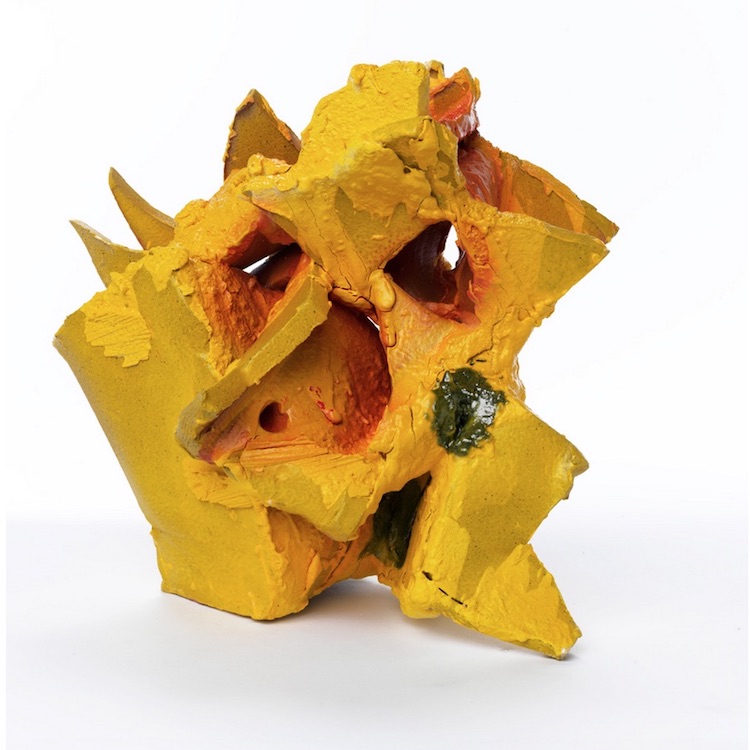Welcome back to our first Spotted of 2018. Spotted is our weekly must-see list of art from the world of contemporary ceramics and contemporary ceramic art. This week we begin with the work of Irish ceramist Sara Flynn.
Sara Flynn
We recently highlighted Sara Flynn’s Chance Encounters III exhibition at Loewe’s Miami boutique at Art Basel Miami in our all things British Ceramics week, and we wanted to take a second look at this Flynn’s work which exquisitely balances in the liminal space of sculpture and vessel. Flynn explains how she began her explorations in her artist statement.
Having begun my career producing small-scale functional pots, as my skill has increased I have moved entirely into making one-off forms which are purely sculptural in their intent. Currently the main elements feeding the development of the work are Process and Finish; coupled with constant exploration and a deepening understanding of form, volume and silhouette. Sympathy with my material is a major aspect feeding how I work and what I make.
Flynn is a Loewe Craft Prize 2017 finalist.
Juan Garaizabal

Juan Garaizabal, Wall Pattern Vase des Tuileries I, 2014, Steel, concrete and wood, 49 1/4 x 32 1/4 x 8 1/4 inches
Pivoting a moment away from clay, we have Spanish conceptual artist Juan Garaizabal’s contour line vessel sculptures and drawings from his Build A Story. Urban Memory of the Lost Tuileries exhibition at De Buck Gallery (New York, June 8 – July 15, 2017).
Known internationally for his monumental public Urban Memories sculptures, Juan Garaizabal is bringing his first solo show to New York at De Buck Gallery. Showcasing the Paris segment of his installations, the exhibition will consist of sketches, production patterns, and a series of sculptures (which Juan calls drawings in space) for which the study was done at the original site of the Palais des Tuileries and its surrounding gardens in Paris. Garaizabal’s main drive for the Urban Memories is the concrete, physical resurrection on site of the memory of a historic structure, valorizing and capturing fragments of architectural foundations that have been lost or destroyed over the course of time.
The works produced can be described as minimal in presence, sustained by only their most essential mechanisms, and thus showcasing the power of absence and the ability to embrace their surroundings
Lisa Scantlebury
Up next we have this funky “jugpack” by Lisa Scantlebury of Plenderleith Scantlebury. Scantlebury explains A jug to put on my back is a critical exploration of clay inspired by by the work of a Czech graphic artist Nadežda Plíšková .
Referencing and inspired by the works of Czech graphic artist, ceramist, sculptor and poet Nadežda Plíšková (1934 – 1999). There isn’t a lot written about her so I wanted to gain knowledge of the processes she would have taken first hand. These jugpacks that I have made are to aid my research for a written extended essay, their function is about the writing rather than the object, as a means to understanding the process and what it means for me to be a ‘Potter’. As a multi-disciplinary artist, Plíšková has inspired my interest in Pottery and desire to explore its function further.
Lynda Benglis

Lynda Benglis, Querechos, 2013, Glazed ceramic, 17 x 19 x 15 inches. Courtesy: Lynda Benglis/Licensed by VAGA, New York
We’ve Spotted Lynda Benglis’ first solo exhibition since 2011 at Blum and Poe (Los Angeles, October 26 — December 16, 2017). Benglis presents works from a sculptural practice that engenders hybrid compositions, embracing the subjective touch of the artist’s hand and the inextricable link between process, material and form.
Each room features a distinct body of work, showcasing the artist’s multifarious range—including glazed ceramics; examples from her bronze fountain series; large-scale biomorphic aluminum sculptures; a constellation of recent paper wall works; and the eleven-foot phosphorescent cast polyurethane HILLS AND CLOUDS (2014), the gallery writes.
Hyperallergic adds whats make these works particularly interesting is that Benglis has ensured their visibility from all perspectives.
They are fluid in space, one with the environment, and beckon interaction. The artwork does not stop where the sculpture ends. Rather, it extends through the gallery space and beyond; three cast bronze sculptures are lined up outside. The work confronts viewers with its bodily reality, making visible the process of its construction in every mound and smear, but still eliciting something ineffable. The works fire the imagination and, through the artist’s intricate use of negative and positive space, raise foundational questions about the gendered body in art.

Lynda Benglis, Lynda Benglis, Manso, 2013, Glazed ceramic, 15 x 23 x 9 inches. Courtesy: Lynda Benglis/Licensed by VAGA, New York
Do you love or loathe our selections from the world of contemporary ceramics and contemporary ceramic art? Share your thoughts in the comments section below.

















Add your valued opinion to this post.